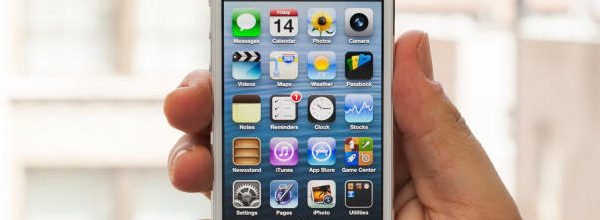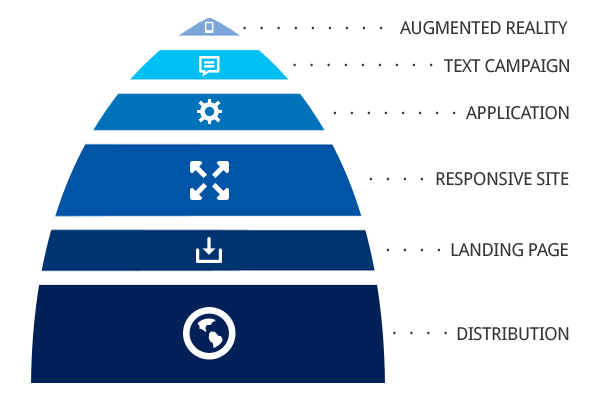How Should I Start My Mobile Strategy?

When it comes to developing a mobile strategy for your tourism organization the suggestions, best practices and peer examples are all over the place.
Some have an app, others a mobile website. Text campaigns, AR, landing pages, where and how should you start your tourism organization’s mobile strategy?
As part of my keynote presentation at the Hoosier Hospitality Conference, I created the Mobile Strategy Decision-Making Pyramid…or, MSDMP for short…to definitively answer the question, where do I start my tourism organization’s mobile strategy?

Reading the Pyramid
The layers or levels in the pyramid should be implemented from bottom to top, building from the basics to some advanced and very specific marketing / communication techniques.
The bands of color are proportionate to the amount of resources you should spend at each level. More on Responsive Design, less on a Texting Campaign.
Level 1: Distribution

The first step in your mobile strategy should be to audit and if needed, improve, the distribution of your organizations information.
Where does information about your hotel, restaurant or attraction live in terms of mobile?
How is it discovered?
Is it accurate?
Start with the big directories of local content first: and .
After the whole Apple Maps snafu, the new Google Maps App for iOS (iPhone), was downloaded 10 million times in a 48 hour period. Without question, Google Maps is one of the most popular, downloaded and utilized apps on any mobile device. Make sure your information can be found and is correct.
Next, move to the major social and geosocial networks.
Use for a quick (and free) search of your current presence. Or, sign-up with a company like for a more robust local marketing monitoring solution.
Put in the required and repeated effort at this level to ensure that your content is available, correct and useful.
Level 2: Landing Page

Organizations will either skip this level, temporarily wait at this level (for a web development update project) or stop at this level, but you should understand why a mobile landing page is important for your mobile strategy.
Now that you have built a solid foundation of distribution for your information, people will be clicking from Google Maps to your website.
And you need to ensure, at a minimum, that the first interaction with your website is a good one.
Set up a mobile redirect based upon screen size, () and direct users to a friendly, mobile-specific landing page.
The goal of this landing page? Delivering critical, decision-making content quickly and in an easy-to-read and -use format.
For example, if you are a restaurant, content such as directions, address, phone number, reservation policy, dress code and perhaps daily specials.
Quick, informative and enough information to convince me to choose your restaurant.
For helping building a mobile landing page, you can call your web developer or utilize .
Ah, feeling more mobile already, right?
Level 3: Responsive Site

If you are building a mobile presence, you should be building a responsive mobile site. Period.
Not mobile friendly, not mobile adaptive and not any of the other agency bullshit buzzwords.

Responsive.
But, don’t get confused or distracted by the technology, a responsive solution is not about making things smaller based upon screen size. It is about making content smarter based upon screen size.
A good responsive mobile site should contain all of the content on your full-size site, but thoughtfully arranged, ordered and presented in a format useful to the consumer.
And a responsive strategy should mean a rethink of your content from a mobile-first approach, not a desktop-first approach.
When you rebuild or update your current digital content to include a responsive design, don’t start by bringing everything over from the old site.
Start with a clean slate.
And start with a mobile / responsive focus.
Advanced Mobile Strategy
Up until this point, the previous levels represent a nearly universal mobile strategy. But the next three levels required a specific use case, consumer need and business goal to be successful.
Executing any of these levels simply because a competitor is doing it, or it looks cool, is a waste of your mobile strategy.
Level 4: Mobile Application

The majority of DMOs, CVBs, hotels, restaurants, attractions, museums, water parks, graveyards, Space Needles and other tourism-related businesses do not need a mobile application.
iPhone, iPad or Android.
You simply don’t need one.
Why? Because the majority of the mobile goals you need to accomplish can be completed effectively with a mobile website.
Only organizations with a specific consumer need or specific use case should build a mobile app.
For example, the banking app on your phone likely contains a deposit by phone feature…where you snap a picture of your check and deposit it via the magic of the internet…a feature that would have been complex and costly, if not impossible, if built as a mobile website.
Strong consumer need, strong use case.
If you are considering a mobile application, ensure that you have a strong consumer need, a clear use case scenario and defined goals.
Level 5: Text Campaign

The statistics are tantalizing. But the execution of a text or SMS marketing campaign is complex and difficult.
Why? Because consumers view texting from a different perspective than mobile applications or email. It is a personal communication tool. Heavily guarded against spam. And for many younger Americans, their preferred method of communication.
Again, it is tantalizing, but the statistics are clear: (.PDF).
While there are certain use cases where a SMS campaign would be a solid strategy, those are few and far between. Which is why text campaigns sit at the top of the pyramid.
Few of our peers should attempt them, and their overall place in your mobile strategy should be small in proportion to a responsive site and mobile distribution.
Level 6: Augmented Reality

Augmented Reality or AR is a fascinating example of technology merging with the real world. Previously highlighted via mobile, now being carried by the development of .
But for 99% of you, our peers, potential readers, AR is not a topic that should appear in your mobile strategic plan.
The technology is simply too young, with too much ongoing development, for you to consider at this point.
In fact, the few examples of AR technology currently in the marketplace commonly utilize directory content to populate the experience.
The same directory content you should be populating and managing at level 1.
Your Mobile Strategy
While your mobile strategy may contain different elements or tactics, we are confident that the majority of tourism organizations…DMOs, attractions or hotels…should follow the structure and approach of the mobile strategy pyramid.
6 clear levels to build a solid mobile strategy.
Receive New Travel 2.0 Articles via Email |
